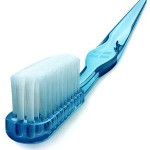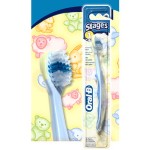 What influences you to choose your present/last tooth brush? Did you purchase your last tooth brush based on its design, color or simply by its brand? In fact, choosing a correct tooth brush is an important step in keeping your teeth healthy and plaque-free.
What influences you to choose your present/last tooth brush? Did you purchase your last tooth brush based on its design, color or simply by its brand? In fact, choosing a correct tooth brush is an important step in keeping your teeth healthy and plaque-free.
Tips for choosing a right tooth brush:
Tooth brush bristles
-Â Â Â Â Â Â Hard bristled tooth brush can lacerate our gums and cause tooth abrasion especially around your gum line. Thus, you should always choose a soft bristled tooth brush (0.15-0.18mm) to minimize injury to your gums. Besides that, soft bristles provide better cleaning ability especially around the gingival margin.
-Â Â Â Â Â Â Pick a tooth brush which has round ended bristles. They are less abrasive and destructive to the oral tissues compared to sharp end bristles.
-Â Â Â Â Â Â Tooth brush bristles are made of nylon, polyester or even natural material. Nylon bristles are said to be more long lasting and hygienic compared to polyester bristles.
Tooth brush head
-      Brush head size should be appropriate according to the size of your oral cavity. It should be able to reach everywhere in your mouth. Size of toothbrush head recommended by American Dental Association is 1 inch in length and ½ inch by width where a length of 1.5cm tooth brush head is suitable for a child.
Â
Tooth brush handle
-Â Â Â Â Â Â Tooth brush handles can come in various designs such as straight handle, contra angle handle, flexible handle and etc. Most importantly, choose a tooth brush which has a handle that allows a firm grip and good control.
Other factors that you should consider when choosing a tooth brush:
-      Choose a tooth brush which is appropriate for your children’s age, size, and stage of development. Companies such as Oral B offers Stages tooth brushes which are specially designed according to your children’s age.
 Stage 1 tooth brush: suitable for infants from 4 to 24 months
Stage 1 tooth brush: suitable for infants from 4 to 24 months
Stage 2 tooth brush: suitable for kids aged 2 to 4 years old
Stage 3 tooth brush: suitable for kids aged 5 to 7 years old
Click here to read more on choosing the best tooth brush for kids
http://www.intelligentdental.com/2010/12/19/best-toothbrushes-for-kids/
-Â Â Â Â Â Â Seek professional advice from your dentist and ask him to recommend a tooth brush which is suitable for you.
-Â Â Â Â Â Â Choose an orthodontic tooth brush if you are an orthodontic patient. They are specially designed with V shaped bristles that help to remove plaque around teeth and braces.
Electric tooth brush vs manual tooth brush
Electric tooth brush is recommended for older patients or people who have less manual dexterity (arthritis patients). Electric tooth brushes perform better than manual toothbrushes in terms of removing plaque, stain and calculus. However, manual tooth brushes can achieve similar results with electric toothbrush if they are used effectively. So, judge yourself or consult a dentist whether you should use an electric tooth brush.
When to change your toothbrush
-Â Â Â Â Â Â Replace your tooth brush every 3 months (Recommended by American Dental Association)
-Â Â Â Â Â Â When your tooth brush begins to worn out.
-Â Â Â Â Â Â When your tooth brush indicator/color has worn off.
-Â Â Â Â Â Â After an illness such as sore throat, flu, Tooth brush can harbor a lot of microorganisms which can cause reinfection.